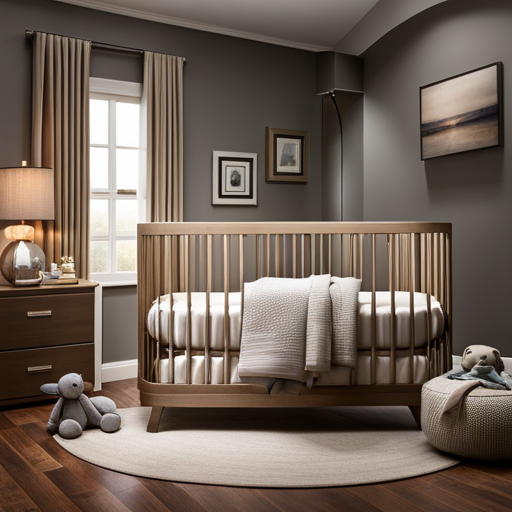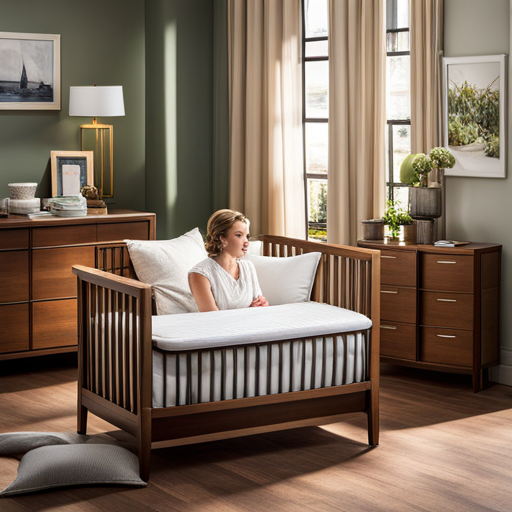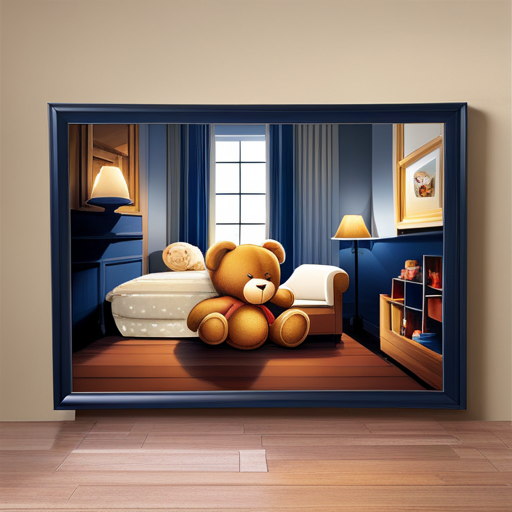"Cherishing Little Steps - A Haven for Baby and Family Journeys"
Putting Baby to Sleep
Are you struggling to put your baby to sleep? Don’t worry, we’ve got you covered!
When it comes to getting your little one to drift off peacefully, there are a few simple strategies you can try. By establishing a bedtime routine, creating a sleep-friendly environment, and setting the right temperature, you’ll be well on your way to a restful night for both you and your baby.
Using white noise or soothing music can also help create a calming atmosphere that promotes sleep. And don’t forget the importance of a consistent sleep schedule and encouraging daytime naps.
With these tips and a little patience, you’ll be able to put your baby to sleep with ease. Let’s dive in and make bedtime a breeze!
Key Takeaways
- Establish a consistent bedtime routine and sleep-friendly environment.
- Maintain a comfortable temperature and use appropriate sleepwear.
- Incorporate white noise or soothing music into the sleep routine.
- Follow safe sleep guidelines and deal with sleep regression.
Establishing a Bedtime Routine

To help your baby establish healthy sleep habits, it’s important to consistently follow a bedtime routine every night. Babies thrive on routine and predictability, so having a set routine before bedtime can signal to your little one that it’s time to wind down and prepare for sleep.
One way to establish a bedtime routine is by using sleep cues. Sleep cues are signals that let your baby know it’s time to relax and sleep. These cues can include dimming the lights, playing soft music, or giving a warm bath. By consistently using these cues, your baby will start associating them with sleep and it will become easier for them to settle down.
Another important aspect of a bedtime routine is reading bedtime stories. This not only promotes language development, but it also creates a soothing and calming environment for your baby. Choose age-appropriate books with simple and repetitive stories, as this can help your baby feel comforted and relaxed. Make sure to read in a soft and gentle voice, creating a cozy and intimate atmosphere.
Creating a Sleep-Friendly Environment

Create a sleep-friendly environment for your baby by ensuring that the room is quiet, dark, and comfortable.
Creating a calm atmosphere is essential in helping your baby settle down and fall asleep easily. Start by minimizing distractions in the room. Remove any toys, electronics, or bright objects that may catch your baby’s attention and keep them awake.
Consider using blackout curtains or blinds to block out any excess light from outside, as darkness signals to the brain that it’s time to sleep. Additionally, try using a white noise machine or a fan to create a soothing background noise that can drown out any disruptive sounds and promote relaxation.
It’s also important to keep the room at a comfortable temperature, around 68-72 degrees Fahrenheit, as a room that’s too hot or too cold can disturb your baby’s sleep.
Setting the Right Temperature

Maintain a comfortable temperature in your baby’s room to promote a peaceful and restful night’s sleep. The ideal room temperature for your baby’s sleep environment is between 68 to 72 degrees Fahrenheit (20 to 22 degrees Celsius). This range ensures that your little one is neither too hot nor too cold during the night.
When dressing your baby for bedtime, choose breathable and lightweight sleepwear that’s appropriate for the current temperature. Avoid overdressing your baby, as overheating can increase the risk of sudden infant death syndrome (SIDS). Opt for a onesie or a light sleeper, and use a sleep sack or swaddle to keep your baby cozy without the need for loose blankets.
In addition to maintaining the right temperature, it’s also important to monitor the room’s humidity. Dry air can cause discomfort and make it harder for your baby to sleep. Using a humidifier can help add moisture to the air and create a more comfortable sleep environment. Aim for a humidity level between 30% and 50% to keep your baby’s nasal passages moist and reduce the risk of congestion.
Using White Noise or Music

You can easily incorporate white noise or music into your baby’s sleep routine to help them relax and fall asleep more easily. Many parents wonder whether using a sound machine or playing lullaby CDs is more effective. Let’s explore the benefits of using white noise or music for both babies and adults.
| Sound Machines | Lullaby CDs |
|---|---|
| Provide consistent background noise | Offer soothing melodies |
| Can be adjusted to different volumes and frequencies | May have calming lyrics |
| Help drown out other noises that may disturb sleep | Create a familiar and comforting environment |
| Portable and convenient to use | Require a CD player or music device |
When it comes to babies, both white noise and lullaby music can be effective in promoting sleep. White noise machines provide a constant sound that mimics the noises heard in the womb, creating a familiar and comforting environment for your little one. On the other hand, lullaby CDs offer soothing melodies that can help calm and relax your baby before bedtime. It ultimately depends on your baby’s preferences and what works best for them.
As for adults, using white noise or soft music can also have numerous benefits for sleep. White noise can help mask disruptive sounds and create a more peaceful sleep environment. It can also help individuals with tinnitus or those who have trouble falling asleep due to racing thoughts. Soft music, on the other hand, can have a calming effect and promote relaxation before bedtime.
Implementing a Consistent Sleep Schedule

To establish a consistent sleep schedule for your baby, it’s important to regularly set bedtime and wake-up times. Consistency is key when it comes to helping your little one develop healthy sleep habits. Here are some practical suggestions to help you implement a consistent sleep schedule:
-
Create a calming bedtime routine: Establish a soothing routine that signals to your baby that it’s time to wind down and prepare for sleep. This can include activities such as a warm bath, gentle massage, or reading a bedtime story.
-
Avoid stimulating activities before bed: Limit your baby’s exposure to screens, bright lights, and loud noises in the hour leading up to bedtime. These activities can interfere with their ability to relax and fall asleep.
-
Use sleep training techniques: There are various sleep training methods available, such as the Ferber method or the gentle sleep training approach. Research different techniques and choose one that aligns with your parenting style and your baby’s needs.
-
Create a sleep-friendly environment: Make sure your baby’s sleep space is comfortable, dark, and quiet. Consider using white noise or a sound machine to create a soothing atmosphere.
-
Bedtime snack suggestions: Offering a small, nutritious snack before bedtime can help satisfy your baby’s hunger and promote better sleep. Opt for foods that are easy to digest, such as a banana or a small serving of yogurt.
Encouraging Daytime Naps

Establishing a regular nap schedule for your little one is crucial for their overall sleep health. Nap time strategies play a vital role in ensuring that your baby gets the rest they need during the day. By incorporating these strategies into your daily routine, you can encourage your baby to take regular and restorative daytime naps.
One effective strategy is to create a calming environment for nap time. Make sure the room is dark, quiet, and at a comfortable temperature. Use white noise machines or soft lullabies to create a soothing atmosphere. Additionally, establish a consistent pre-nap routine, such as reading a book or singing a lullaby, to signal to your baby that it’s time to sleep.
Daytime naps offer several benefits for your little one. They not only help them recharge and refuel, but also contribute to their cognitive development. Research shows that babies who take regular naps have improved memory, attention span, and problem-solving skills. Napping also allows their brains to process and consolidate information, leading to better learning and memory retention.
Introducing a Transitional Object

Creating a familiar and comforting sleep environment can be further enhanced by introducing a transitional object to your baby. These objects, such as comforting toys or soothing blankets, can provide a sense of security and comfort, helping your baby feel safe and relaxed as they drift off to sleep.
Here are five reasons why introducing a transitional object can be beneficial for your little one:
-
Promotes self-soothing: A transitional object can become a source of comfort for your baby, allowing them to learn self-soothing techniques and develop a sense of independence.
-
Provides familiarity: Having a familiar object, like a favorite teddy bear or a soft blanket, can create a sense of familiarity and routine, which can promote better sleep patterns.
-
Reduces separation anxiety: When your baby has a transitional object, it can help ease their anxiety when you’re not around, providing them with a familiar connection in your absence.
-
Acts as a sleep cue: By associating their transitional object with sleep, you can help your baby understand that it’s time to rest and relax.
-
Offers comfort during transitions: Whether your baby is transitioning from co-sleeping to their own crib or going through a developmental milestone, a transitional object can provide comfort and stability during these changes.
Introducing a transitional object to your baby’s sleep routine can have a positive impact on their overall sleep experience, promoting feelings of security and comfort. It’s important to choose a safe and age-appropriate object that your baby can easily cuddle and hold onto while they sleep.
Practicing Safe Sleep Guidelines

When it comes to putting your baby to sleep, it’s important to follow safe sleep guidelines. These guidelines are designed to ensure that your little one stays safe and comfortable throughout the night.
One important aspect of safe sleep practices for newborns is to avoid using sleep positioners. While they may seem like a helpful tool to keep your baby in place while sleeping, they can actually pose a serious risk of suffocation. It’s best to keep your baby’s sleep surface clean and free of any extra items.
Another important safe sleep practice is to place your baby on their back to sleep. This position has been proven to reduce the risk of sudden infant death syndrome (SIDS). Make sure the crib or bassinet is free of loose bedding, pillows, and stuffed animals that could potentially suffocate your baby. Avoid using blankets, as they can pose a risk of suffocation as well. Instead, dress your baby in a sleep sack or a swaddle that allows their arms to be free.
Remember to keep the room at a comfortable temperature and use a firm mattress with a fitted sheet. It’s also important to make sure that the crib or bassinet meets safety standards. By following these safe sleep guidelines, you can ensure that your baby has a restful and safe night’s sleep.
Dealing With Sleep Regression

To handle sleep regression, you’ll need to adapt your baby’s sleep routine. Sleep regression is a period when your baby’s sleep patterns suddenly change, causing them to wake up more frequently during the night or have difficulty falling asleep. It’s a common phase that many babies go through, typically occurring around 4 months, 8 months, and 18 months of age.
Here are some practical tips to help you deal with sleep regression:
-
Stick to a consistent bedtime routine: Establishing a calming routine before bed can signal to your baby that it’s time to sleep.
-
Create a sleep-friendly environment: Make sure the room is dark, quiet, and at a comfortable temperature for your baby.
-
Offer comfort during teething: Teething can disrupt sleep, so provide your baby with teething toys or teething gels to alleviate discomfort.
-
Manage separation anxiety: Help your baby feel secure by gradually introducing them to independent sleep. Start by leaving them for short periods and gradually increase the time.
-
Be patient and flexible: Remember that sleep regression is temporary, and your baby will eventually settle back into a regular sleep pattern.
Frequently Asked Questions
How Can I Handle My Baby’s Sleep Regression?
Handling your baby’s sleep regression can be challenging. Managing teething discomfort and coping with separation anxiety are key. Stay consistent with bedtime routines, offer comfort, and provide a safe sleep environment. Remember, this phase is temporary, and you’re not alone.
What Are Some Safe Sleep Guidelines That I Should Follow for My Baby?
To ensure your baby’s sleep safety, follow these guidelines: place them on their back in a crib with a firm mattress, avoid loose bedding or toys, and maintain a comfortable room temperature. By adhering to these recommendations, you can reduce the risk of common sleep problems.
When Should I Introduce a Transitional Object to My Baby?
Introducing a transitional object to your baby can provide comfort and security during sleep. Benefits include promoting self-soothing and reducing separation anxiety. Choose a soft, safe object like a stuffed animal, and avoid objects with small parts or loose threads.
How Can I Encourage Daytime Naps for My Baby?
To encourage daytime naps, start by establishing a consistent bedtime routine. Use sleep cues, like dimming the lights and playing soothing music. Create a calm and cozy environment that signals it’s time to rest.
What Are Some Tips for Establishing a Consistent Sleep Schedule for My Baby?
To establish a consistent sleep schedule for your baby, focus on establishing a routine and incorporating bedtime rituals. Consistency is key, so try to follow the same sleep routine every night. This will signal to your baby that it’s time to sleep.
Conclusion
In conclusion, by establishing a consistent bedtime routine, creating a sleep-friendly environment, and following safe sleep guidelines, you can help your baby sleep soundly.
Setting the right temperature, using white noise or music, and introducing a transitional object can also contribute to better sleep.
Additionally, encouraging daytime naps and dealing with sleep regression will further support your baby’s sleep patterns.
Remember, following these evidence-based techniques will promote healthy sleep habits for your little one.


